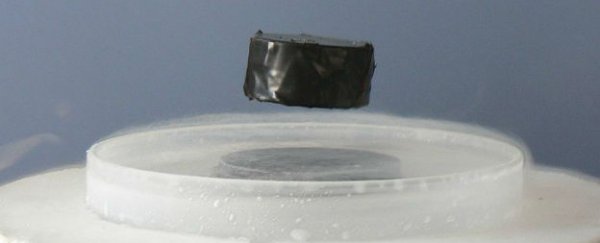Physicists from the Max Planck Institute for the Structure and Dynamics of Matter have kept a piece of ceramic in a superconducting state, disproving the widely-held assumption that materials need to be cooled to temperatures of at least -140 degrees Celsius to achieve superconductivity.
Superconducting materials have the potential to change everything that relies on electrical power, such as power grids, transportation, and renewable energy sources. This is because they're able to transport electric currents without any resistance, which means they're incredibly efficient and cost-effective to run. Except right now, they're not, because in order to get a material to a superconducting state, it needs to be cooled to near absolute zero temperatures, which has really hampered the potential of this technology up to this point.
Over the past few decades, scientists have come to realise that metals cooled to temperatures of around -273 degrees Celsius using liquid nitrogen or helium aren't the only materials capable of reaching a superconducting state. During the 1980s, it was discovered that ceramic materials can reach this state at significantly higher (and yet still extremely cold) temperatures of around -200 degrees Celsius. This is why they're called high-temperature superconductors.
One such ceramic material, called yttrium barium copper oxide (YBCO), has since been singled out, thanks to its great potential for use in a range of technical applications such as superconducting cables, electrical motors, and generators. Made from super-thin double layers of a copper oxide material stacked in-between layers made from barium, copper and oxygen, this material is designed to allow the bonding of electrons into what's known as Cooper pairs, the team reports in a press release.
These Cooper pairs of electrons are able to 'tunnel' between the alternating layers "like ghosts can pass through walls, figuratively speaking - a typical quantum effect," they report, but it was thought this could only occur at super-cooled temperatures.
But then the physicists from Max Planck decided to see what would happen if they irradiated the YBCO ceramic material with infrared laser pulses. They found that for a fraction of a second, the ceramic becomes superconducting at room temperature. And when we say "a fraction of a second", we mean a fraction. "It was only a few millionths of a millisecond," says Adam Clark Estes at Gizmodo. "That's a very, very brief lifespan for our amazing new room temperature superconductor. However, the successful experiment is proof that such a thing is possible."
The team suspects this is because the pulses from the laser cause individual atoms in the crystal lattice structure of the ceramic to shift momentarily, which increases the superconductivity of the material.
The team explains the results in a press release from the Max Planck Institute:
"The infrared pulse had not only excited the atoms to oscillate, but had also shifted their position in the crystal as well. This briefly made the copper dioxide double layers thicker - by two picometres, or one hundredth of an atomic diameter - and the layer between them became thinner by the same amount. This in turn increased the quantum coupling between the double layers to such an extent that the crystal became superconducting at room temperature for a few picoseconds."
Publishing the results in the journal Nature, the team hopes the discovery will help drive the potential of superconductor technology in the future. "It could assist materials scientists to develop new superconductors with higher critical temperatures," said lead researcher, physicist Roman Mankowsky. "And ultimately to reach the dream of a superconductor that operates at room temperature and needs no cooling at all."
